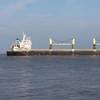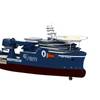Conoco, Inc's Domestic Marine Division, Houston, Texas has taken delivery of the first of four 75-ft. by 30-ft. by 10-ft. towboats that feature design, safety and environmental improvements over existing vessels working the inland waterways and the ICWW. .
Conoco, Inc., merged with Phillip Petroleum Company on August 30, 2002 to form ConocoPhillips a company with $75 billion in assets. The Conoco Marine Division has seven towboats and 14 barges.
These 2,000 hp twin-screw vessels are being built by Orange Shipbuilding, Orange, Texas, a division of Conrad Industries of Morgan City, La. and will replace older vessels.
"We are raising the bar for towboat design, machinery and marine systems by constructing American Bureau of Shipping class boats," said Karen Stacy, director of Conoco Domestic Marine.
Among the design features on these vessels are double-hulled fuel tanks. Double hulling is now standard on all Conoco crude oil tankers and tank barges operating in U.S. waters.
The new towboats are being built to the same double hull standards.
"The three other towboats will be delivered over the next few months, " said Joe Waldrep, project manager for Orange Shipbuilding. "The first vessel is named Spirit and will be followed by Integrity, Innovator and Liberty," Waldrep added.
Additional environmental friendly and safety features on the vessels include CO2 extinguishing systems, fuel shutdowns, fire detection systems and fire fighting systems.
The mechanical systems on the vessels are as state-of-the-art as they are environmental friendly starting with the main propulsion engines. A pair of Cummins KTA38-MO diesel engines rated at 1,000 hp each at 1,800 rpm provides main power. These engines are compliant with International Marine Organization (IMO) and Environmental Protection Agency (EPA) emission standards.
Reduction in fuel consumption and lube oil utilization are other advantages of these engines, according to Antonio Valdes, manager of Conoco Marine.
The engines use Ingersoll Rand air starters powered by Quincy air compressors. Engine cooling is via Fernstrum keel coolers. The coolers are sized for 95-degree F. salt water, vessel speed of two mph and the engines at maximum horsepower.
The engines are coupled to Reintjes reduction gears supplied by Karl Senner of New Orleans. Special five bladed propellers are used that are 50 percent more efficient at reducing hull vibration making for a much smoother ride, according to Antonio Valdes, manager of Conoco Marine. The propellers were manufactured by Rolls Royce and supplied by Johnny's Propeller Shop, Morgan City, La.
A pair of Cummins 6BT gensets are onboard producing 55 kW each of ship's power. They are also cooled by Fernstrum keel coolers. Cummins Southern Plains, Houston, Texas, supplied all four engines.
One engine is air started with an Ingersall Rand air starting system while the other genset uses a 12 VDC starting system.
The gensets feed a common switchboard supplied by Quality Power, Pass Christian, Miss. Quality also supplied all of the Square D distribution and breaker panels and other switchgear.
The steering system is an electric over hydraulic system with full follow up supplied and installed by Advance Marine, Gray, La. The steering system is driven by a dual 15-hp electric pump unit.
The hydraulic system is sized to produce 1,500 PSIG operating pressure and can move either set of single plate rudders from 40 degrees port to 40 degrees starboard in under 8 to 10 seconds under full power at design towing speed.
The towboats have two steering rudders and four flanking rudders with Aqualoy 17 stock sized per ABS rules.
The environmental sensitivity of the design of this vessel is evident in the design of sewage, fuel delivery and fire suppression systems. The vessel uses an Owens model B stainless steel Marine Sanitation Device. The unit features a stainless steel tank and is Coast Guard and IMO approved with alarm panels.
The diesel fuel system has emergency air-operated shut-offs to stop fuel from flowing to the main and generator engines. Remote shut-off stations are located .on the outside of the main deck house both port and starboard and are contained in a recessed housing adjacent to the CO2 system controls.
The CO2 system is a fixed-flooding system by Ansul installed adjacent to the engine room and can be activated from stations next to the emergency fuel shutoff. The system has a warning light, siren, and is capable of shutting all ventilation louvers and stopping all supply and exhaust fans in the main engine room.
The hull of the vessels are divided into compartments to house the main machinery, auxiliary systems along with a 24,000 gallon double bottom diesel fuel tank, an 11,000 gallon fresh water tank and a 500 gallon tank for bilge slop. A self-standing 500-gallon lubricating oil tank is also included in the hull.
The main deck house holds the galley and mess, one double crew stateroom, one head, the laundry area as well as stores spaces fore and aft.
The second deck contains two double and one single crew rooms, one head as well as interior access to the pilothouse above and the main deck spaces below.
The pilothouse is equipped with three ICOM radios, (one in the messing area), two Furuno radars, a Ritchie compass, two 19-in. Xenon searchlights from Carlisle and Finch, a pair of rudder angle indicators, a Furuno GPS system and a digital depth sounder.
Main engine shut down can be controlled from the pilothouse. Main engine start and shut down is activated from the engine room.
Crew comforts were also a priority on the vessel. All crew rooms are heated and air conditioned as is the pilothouse and the galley/messing area. Noise abatement was a key design consideration. The generator engines are mounted on Lo-Rez vibration isolators and special attention was given to noise abatement insulation of all decks and bulkheads that join the crew spaces and machinery spaces.
Among the safety enhancements on the vessel is a fire detection system. Sensors in the engine room, generator room, crew spaces, pilothouse and galley alert the pilothouse display panel if conditions warrant.
An alarm system monitors 40 critical pressure, level and temperature parameters. Alarm panels are located in the pilothouse and in the engine room.
The fire detection system and the alarm system was designed and installed by Eagle Control Systems of Baton Rouge, La.
The entire vessel was painted using coatings by International Paint, Houston, Texas.
There is no doubt these towboats are a major step forward in the evolution of pushboat design respecting the environment around the vessel and the employees that serve onboard.
"These four new generation towboats will replace older assets to enhance our productivity and reinforce our commitment to respecting the environment," said Rick Oshio, Conoco vice president and general manager, supply and trading materials and services.
In addition to building four towboats, Conoco Marine has also built a pair of 17,000-barrel double-bottomed petroleum tank barges to replace two 10,000-barrel barges. These barges were built by Trinity Industries, Dallas, Texas and painted by Bollinger-Calcasieu, Sulphur, La.
Orange Shipbuilding is one of the busiest small shipyards on the Gulf Coast. In addition to the four Conoco towboats, Orange Shipbuilding is building a Z-Drive Harbor Tug for Harbor Fuel Services of Puerto Rico, a 180-ft. by 44-ft. auto/passenger ferry for the State of North Carolina Department of Transportation and continues to build tugs for the U.S. Army.
Subscribe for
Maritime Reporter E-News
Maritime Reporter E-News is the maritime industry's largest circulation and most authoritative ENews Service, delivered to your Email five times per week













